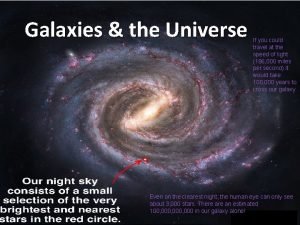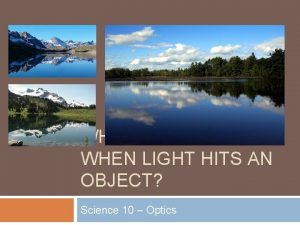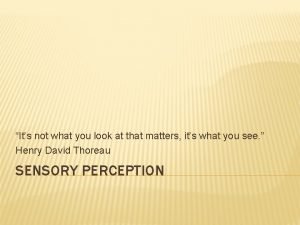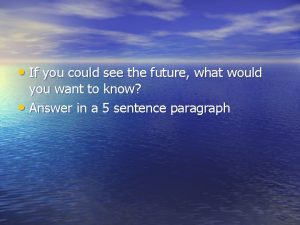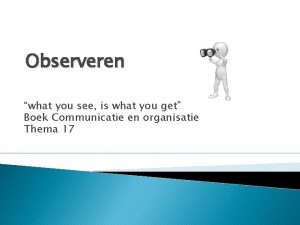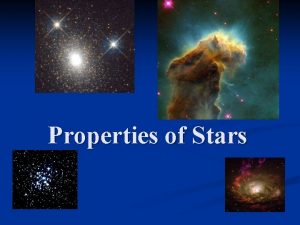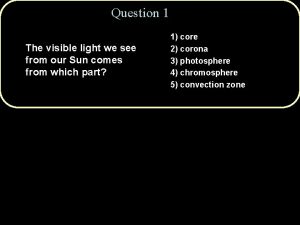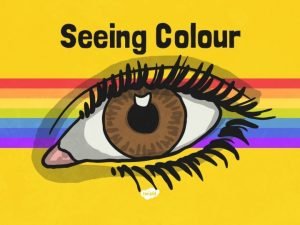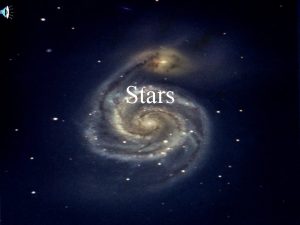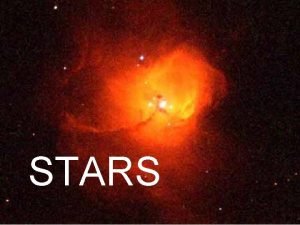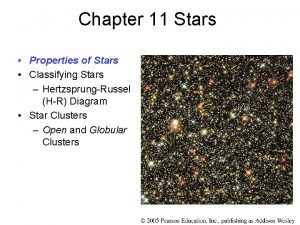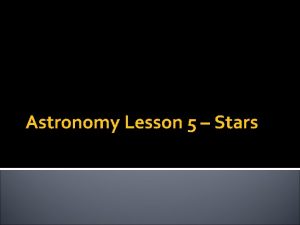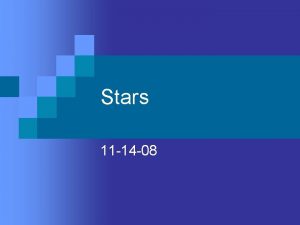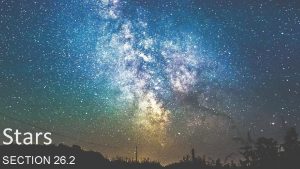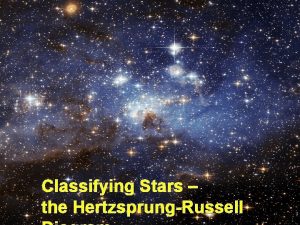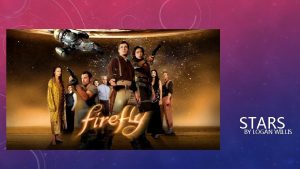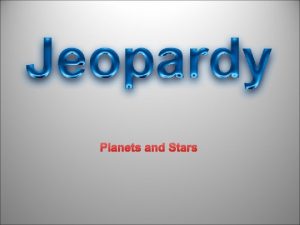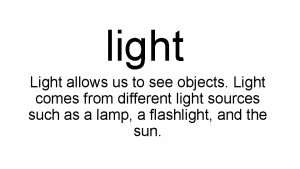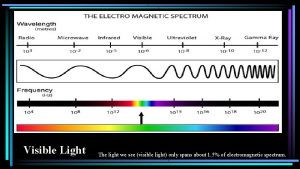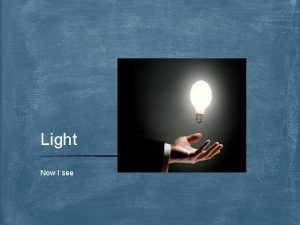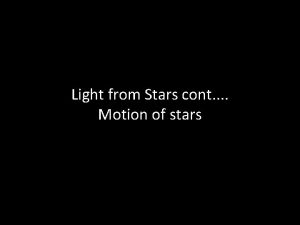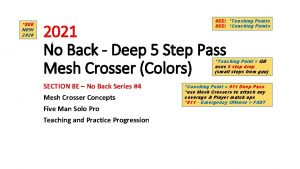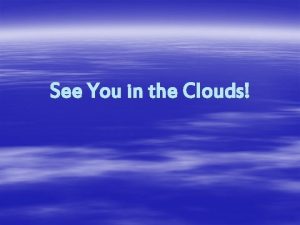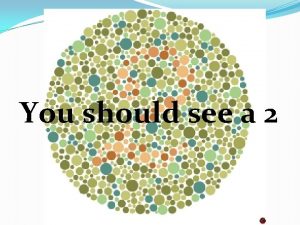Light from Stars When you see the light








































- Slides: 40

Light from Stars When you see the light from a star, it is light that left it many years ago. n Light travels very fast, but the distances in space are so great that it takes years for the light to reach Earth. -sometimes tens of thousands of years. n The light and other energy leaving a star are forms of radiation. n

Radiation Remember: radiation is energy transmitted through electromagnetic waves. n Because of electric and magnetic properties of this energy, it is called electromagnetic radiation. n Electromagnetic waves carry energy through both empty space and matter. n

How do we hear astronauts in space? n n Sound waves are mechanical waves; they can’t travel through space So, how do we hear astronauts in space?

How do we hear astronauts in space? n When they speak into a microphone, the sound is converted into electromagnetic waves called radio waves. The radio waves travel through space and back to Earth where they are converted back into sound.

Electromagnetic Spectrum n All electromagnetic waves have different wavelengths, but the all travel at the speed of light in a vacuum- 300, 000 km/s in a vacuum

Satellites n A satellite is any object that revolves around another object.

Satellites When an object enters space, it will travel in a straight line until the Earth’s gravity pulls it back toward Earth. n Because the satellite is traveling forward and falling toward Earth at the same time, the satellite will travel in a curved path around Earth known as an orbit. n

2 Types of Satellites Natural & Artificial There are both natural and artificial satellites.

Natural Satellites n n The moon is a natural satellite. It orbits the Earth.

Sputnik- 1 st Artificial Satellite

Sputnik 1 n Sputnik was launched by the Soviets in 1957, marking the beginning of space exploration.

Space Probes A space probe is an instrument that gathers information and sends it back to Earth. Space probes travel far into space. n Examples: Voyager I and II (didn’t land on a planet), Viking (did land), Galileo (dropped probe onto Jupiter) n

Space Program & Important People Yuri Gagarin & President Kennedy

Yuri Gagarin n In 1961, Yuri Gagarin became the first human in space.

President Kennedy n President Kennedy called for the US to put the first man on the moon by the end of the decade.

Projects that led to man on the moon n Project Mercury Project Gemini Project Apollo

Project Mercury n Project Mercury- orbit a crewed spacecraft around Earth and bring it back safely

Alan Shepard n 1961 - Alan Shepard became 1 st US citizen in space n n n Was not on Apollo 13 because of an ear infection Apollo 14 -oldest man on moon (47) Hit golf balls on moon

John Glenn n 1962 - John Glenn became the 1 st US citizen to orbit the Earth

Project Gemini n Project Gemini- two teams of astronauts met and connected

Project Gemini

Project Apollo n Project Apollo- July 20, 1969 Apollo 11 landed on the moon n Saturn V that launched Apollo 11

Project Apollo n Neil Armstrong was the first man to walk on the man.

Neil Armstrong n “That’s one step for a man, one giant leap for mankind. ”

Apollo 11 - Edwin Aldrin n n Edwin Aldrin was the 2 nd man to walk on the moon. He and Armstrong explored for 2 hours.

Apollo 11 - Michael Collins n n Michael Collins remained in the Command Module. A total of 6 lunar landings brought back 2000 samples of moon rock. The program ended in 1972.

Space Shuttle n A space shuttle is a reusable spacecraft that transports astronauts, satellites, and other materials to and from space.

Space Shuttle n At launch, the space shuttle orbiter stands on end and is connected to an external liquid-fuel tank and two solid-fuel booster engines.

Space Shuttle n When the shuttle reaches an altitude of about 45 km, the emptied solid-fuel booster rockets drop off and parachute back to earth. They are recovered and reused again.

Space Shuttle n The larger liquid fuel tank eventually separates and falls back to Earth. It is not recovered.

Space Shuttle n Once the space shuttle reaches space, it orbits Earth.

Space Shuttle Landing n At the end of a mission, the space shuttle orbiter glides back to Earth and lands like an airplane. The parachute slows it down.

Space Shuttle Challenger Disaster n n n January 28, 1986 7 crew members diedone of which was teacher Christina Mc. Auliffe Mc Auliffe was first member of the Teachers in Space Program

Challenger

Space Stations n A space station has living quarters, work and exercise space, and all the equipment and support systems needed to live and work in space.

Skylab n Skylab was a space station put up in 1973. In 1979 it was abandoned and fell back into earth’s atmosphere and burned up

Skylab Launch

Skylab Launch

Mir n Mir was a Soviet space station.

International Space Station n International Space Station serves as a research lab for several countries. Permanent crew Scientists on Earth have almost instant access to experiments and can modify when needed
 There are millions of stars in the sky
There are millions of stars in the sky Jupiler
Jupiler Where light is hitting an object
Where light is hitting an object It's not what you look at that matters, it's what you see.
It's not what you look at that matters, it's what you see. If you could see the future what would you do
If you could see the future what would you do Good morning nice to see you
Good morning nice to see you Good morning good afternoon
Good morning good afternoon Observatieplan stappen
Observatieplan stappen Light light light chapter 23
Light light light chapter 23 Light light light chapter 22
Light light light chapter 22 Light light light chapter 22
Light light light chapter 22 How do you classify stars
How do you classify stars The visible light we see from our sun comes from which part
The visible light we see from our sun comes from which part Hope is being able to see that there is light
Hope is being able to see that there is light Light enable us to
Light enable us to Hát kết hợp bộ gõ cơ thể
Hát kết hợp bộ gõ cơ thể Frameset trong html5
Frameset trong html5 Bổ thể
Bổ thể Tỉ lệ cơ thể trẻ em
Tỉ lệ cơ thể trẻ em Gấu đi như thế nào
Gấu đi như thế nào Thang điểm glasgow
Thang điểm glasgow Alleluia hat len nguoi oi
Alleluia hat len nguoi oi Các môn thể thao bắt đầu bằng tiếng chạy
Các môn thể thao bắt đầu bằng tiếng chạy Thế nào là hệ số cao nhất
Thế nào là hệ số cao nhất Các châu lục và đại dương trên thế giới
Các châu lục và đại dương trên thế giới Cong thức tính động năng
Cong thức tính động năng Trời xanh đây là của chúng ta thể thơ
Trời xanh đây là của chúng ta thể thơ Mật thư anh em như thể tay chân
Mật thư anh em như thể tay chân Làm thế nào để 102-1=99
Làm thế nào để 102-1=99 độ dài liên kết
độ dài liên kết Các châu lục và đại dương trên thế giới
Các châu lục và đại dương trên thế giới Thể thơ truyền thống
Thể thơ truyền thống Quá trình desamine hóa có thể tạo ra
Quá trình desamine hóa có thể tạo ra Một số thể thơ truyền thống
Một số thể thơ truyền thống Cái miệng nó xinh thế chỉ nói điều hay thôi
Cái miệng nó xinh thế chỉ nói điều hay thôi Vẽ hình chiếu vuông góc của vật thể sau
Vẽ hình chiếu vuông góc của vật thể sau Biện pháp chống mỏi cơ
Biện pháp chống mỏi cơ đặc điểm cơ thể của người tối cổ
đặc điểm cơ thể của người tối cổ Thứ tự các dấu thăng giáng ở hóa biểu
Thứ tự các dấu thăng giáng ở hóa biểu Vẽ hình chiếu đứng bằng cạnh của vật thể
Vẽ hình chiếu đứng bằng cạnh của vật thể Phối cảnh
Phối cảnh

